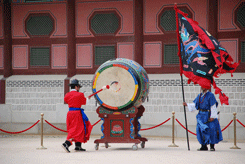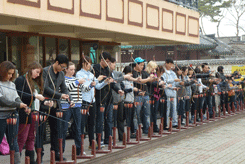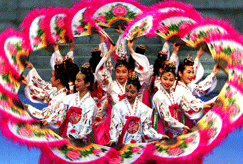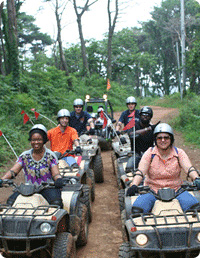INCENTIVE
Team Building
 |
 |
 |
EXODUS DMC offers a complete range of incentive packages, corporate meetings, and team building activities. A team is more than a group of people. Team building is not just about bringing a team together but about achieving a common goal and making each member a part of the team more than being an individual. Various team building programs can be employed to add great value to your incentives. We organize creative teamwork games and unique activities with specific focus on your objectives.
Tug of War
Juldarigi is a Korean tug-of-war game in which two teams try to drag a thick rope to one side or the other. It is the biggest of the team games. Though it differs from region to region, it is usually enjoyed on the fifteenth day of the first lunar month. Players are divided into the eastern part and the western part or the upper horse and the lower horse when playing Juldarigi. It has been believed that there will be a good harvest if the team holding the female end wins the game. When a gong is stuck, each team does its best to pull on the rope. With cries and shouts vibrating in the air, all the players grasp the rope tightly. As the game requires team play, each leader controls his own team by waving a flag. The winner is decided by the amount of rope dragged across the midpoint. Physically exhausting and emotionally climaxing. Especially with older adults, be careful with this activity, especially if they are unfit or if overexertion is contraindicated.
Korean Archery
Gukgung or Korean Archery has been a popular sport among the Koreans as a means of training the mind and body while nourishing the spirits, since ancient times. The learned elite of Joseon, or the literati, considered it to be as important martial art that they had to learn and practice. They believed archery was good not only for physical and mental discipline but also character cultivation for virtuous men. They enjoyed archery on hunting excursions, and villages held archery contests for young men of the literati class to increase friendship and harmony among them.
Tea Ceremony
Tea ceremony is an invitation to Korean traditional tea culture. The ritual is really precise. The origin of the Korean tea culture dates back to the 1st century AD with the introduction of tea seeds from India. From early on, Korean Buddhists recognized the tea ceremony as a form of meditation. It was shared not only among Buddhist monks but also among Confucian scholars. The royal court ceremony represents the official tea ceremonies performed at the palace.
This group of the noble class who led the high society cultures has no doubt contributed to the development of the content and formality of the guest reception ceremony and the handover to the modern era. The informal and private tea ceremonies were also held by the royal households. Tea ceremonies, as a fundamental element of Korean spiritual and cultural heritage, be revived and restored to bring awareness of the Korean spirit and philosophy.
Spend the time enjoying the peaceful moment of tea-drinking. Spend the time enjoying the peaceful moment of tea-drinking. Many say that tea should be drunk with the five senses. You hear the boiling water with your ears, smell the tea fragrance with your nose, see the tea color with your eyes, taste the tea with your mouth, and feel the warm tea with your hands. They also say that tea has five tastes. It first tastes bitter, then astringent, then sour, spicy, and finally, sweet. Although a short program, you will be impressed with the subtle touch of the Korean tea culture. In addition, tea ceremony strengthens one's character and discipline, and raise society's moral.
Taekwondo
Taekwondo is a Korean traditional martial art and a kind of sports and exercise that mainly uses hands and feet for self-defense. It helps people keep their physical and spiritual health through studying the skills of defense and offense. It also provides body flexibility and skills to control strength, balance, breath, eyes and finally concentration of the spirit, as well as mental discipline to cultivate the spirit of martial art. Although Taekwondo is very much about kicking, punching, self-defense, board-defense, board breaking and competition, it transcends beyond physical boundaries. Taekwondo is a sport that anyone can pick up at any time without the need to have special tools. It is a discipline of mind and body, a modern world sport, and a philosophy. Today, you will experience it under the guidance of the master.
Yutnori
A game derived from ancient divination rituals, Yutnori is enjoyed by people of all ages and is traditionally played during the New Year season. It may be played by two people or two teams pitted against each other, and requires four round wooden sticks about 20 centimeters long, with one flat side. The game board may be drawn on cloth, paper or on the ground, and each team has four markers. The object of the game is to move one's four markers completely around the square diagram of 20 dots before the opponent can do so. Diagonals of nine dots provide short cuts towards home dot, from which markers can exit. A player's move is determined by a toss of the Yut sticks. These are the possible move; Mo, a five dot move, all four sticks fall convex side up; Yut, four dot move, all sticks fall flat side off the floor, Gol, three dots, three of the four fall flat side off the floor, Gae, two dots, two fall flat side visible; and To, one of the sticks falls flat side visible. A toss of Mo or Yut entitles the player another toss and two tosses may be divided among all the player's markers. In one variation of the game, black dot is marked on the flat of one dot. If To occurs (one flat visible) with, the spotted stick, the player moves backward one dot. If marker lands on a dot occupied by opponent's marker, the player takes another turn and the opponent's marker must go back to the beginning and start over. If player's marker lands on a dot occupied by one of its own, both may move around together on single toss of the sticks.
Jegi Chagi
It is a game where a person kicks a Jegi, a Korean shuttlecock somewhat like a hacky sack. Jegi is formed by wrapping coin firmly with paper or cloth strips until it is the size of a fist and has a multi-tassel tail. It is enjoyed mostly on Lunar New Year's day by boys and young men, but it can be played any place and any time if the weather is fine. This game is played separately by each person in a group, or by an entire group in a circle. When each person plays separately, the rules for kicking the Jegi are usually agreed upon in advance by the players. The Jegi can be kicked with one foot or both feet. Standing on one leg, players keep kicking Jegi into the air with the insole of his free foot. The winner is an agile player who keeps the Jegi in the air with a greatest number of the kicks.
Jeju Olle Trekking
Olle is a Jeju word for a narrow pathway leading home from the main street. There are 15 trails developed on the island, each of which is named by the order of its development. On average, each Jeju Olle trail is 15Km in length and offers a unique opportunity to soak in the beauty of Jeju. The courses are not rated for difficulty, but with such a variety of terrain, they can be challenging. However, they are suitable for all ages and abilities. These self-guided trails are marked with distinctive blue or yellow arrows painted on rocks and stationery objects, or blue and yellow ribbons hanging from bushes and trees. You can dip in and out, walking shorter sections as you choose. The trails are open four seasons of the year so that everyone may enjoy the beauty of Jeju all year around.
Oreum Trekking
The program covers world heritage Seongsan Ilchulbong, and Darangsi Oreum trekking. Seongsan Ilchulbong is the island's largest volcanic rock cone which is surrounded on three sides by the ocean rising 182 meters strait from the water. The adventure begins with the climbing of this steep cone up to the spectacular crater surrounded by 99 rock peaks. After the tour, you will venture out well over 2-hour Oreum Trekking. “Oreum” is parasitic volcano in Jeju word. There are 368 Oreums on the island. Dalanghsi Oreum, about 300m above sea level, is one of the most beloved for trekkers for its scenic landscape. On its summit is a huge crater lacking water. The ascent up to the rim of the crater is steep and arduous. But, you are compensated by stunning view spreading below. Being closer to the peak, the ridge gets narrower, and you will soon find yourself scaling on to peak. The wind often gets stronger, but this refreshing air stimulates your senses. After the trekking, drop by Bijarim, an oriental nutmeg forest. It is the largest one in the world consisting of a single species. A total of 2,878 nutmeg trees aged between 300 to 800 years with a height of 7 to 14 meters are growing on an area of 450,000 square meters.
Sailing
Enjoy yachting on the Jeju's southern coastal waters with time for swimming or fishing with lavish lunch served on board. You will drift under sail through turquoise waters, being pampered and waited on, sunning on deck and idly watching the the indented cliffy coastlines and the distant Oreums and Hallsan mountain.
Deep Sea Fishing
Due Korea is surrounded three sides by ocean, it offers a great fishing opportunity around year. The team will have its own fishing boat and enjoy fishing in a small or medium group. In particular, Jeju is a fascinating destinaiton for your fishing adventure. Deep sea fishing competition can be organized - a great way of motivation. Overall 2 hours program is most rewarding.
Pony back riding
Whether you are a beginner rider or a rider with experience horsemanship lessons and periodic reminders about safety around the barn and while handling horses help avoid accidents and definitely keep riders happy and smiling. As the weather invites, you will be given a short course on riding before we go out on the trail. You must wear long pants - no shorts. Boots or closed shoes with a small heel are preferred. Sandals, clogs or open shoes are not allowed. The trail rides provide excitement as well as relaxation. Experience the scenic trails overlooking the rolling Oreums and ocean vistas. Listen to the natural music of woods filled with a wide assortment of flora and fauna along with the sound of horses' hooves meeting the ground. Some of the trails have breathtaking views. These trail rides are sure to please nature lovers and tourists alike. Trails winding through grassland and highland forests of fir and pine trees lend a certain surrealistic fairy-tale-world feel to trail rides.
Kimchi Making
Enjoy a Kimchi-Making session where you will learn how to make delicious kimchi. To make Kimchi, you put a mixed stuffing of various vegetables and condiments into the pickled cabbage which was soaked in salt, and spring onion, garlic ginger, and oyster are also used as usual ingredients. After mixing them together, they are put into the spaces between the leaves of a Chinese cabbage evenly and then the whole cabbage is wrapped with the outermost leaf. The cabbage Kimchi is piled in a large earthenware jar for a month. The program includes Kimchi museum, line tour, Kimchi making, and try on a traditional Korean costume (Hanbok). Making Kimchi is not only interesting but an excellent opportunity to understand the Korean culture and dietary life.






